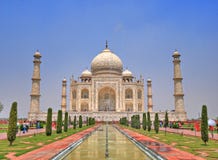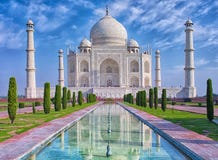Stock Photo: Mughal Architecture Of Taj Mahal In Agra, India
ID 256034701 © Nhungbuocchan | Megapixl.com
The Taj Mahal is a mausoleum complex in Agra, western Uttar Pradesh state, northern India. It is considered the finest example of Mughal architecture a blend of Indian, Persian, and Islamic styles. The Taj Mahal is also one of the world`s most iconic monuments, visited by millions of tourists each year. In 1631, the grief-stricken Emperor Shah Jahan - the greatest of the Mughal builders who was responsible for the city of Shahjahanabad Old Delhi, among and other structures - ordered the building of a tomb to commemorate his third wife, Mumtaz Mahal, a Persian princess, who died giving birth to their 14th child, Gauhara Begum. Construction began in 1632 and the entire site took roughly 22 years to complete, at an estimated cost of about 32 million Rupees 17th century value. The mausoleum itself was completed in 1648; the other buildings and garden were finished some five years later. Roughly 20,000 craftsmen and artisans worked on the project, including calligraphers from Syria and Persia, stone carvers from Bukhara, stone cutters from Baluchistan, mosaicists from southern India, to name but a few of the specialist craftsman employed. On completion, it is said that Shah Jahan ordered the amputation of the chief stone mason`s right hand, to prevent the replication of the Taj Mahal`s exquisite decoration.
CATEGORIES
EXCLUSIVE
Sharing is not just caring, it's also about giving credit - add this image to your page and give credit to the talented photographer who captured it.:
KEYWORDS
agra amazing archaeological architectural architecture archway asia beautiful blend brick century cloud complex considered culture decoration dome empire gate gemstone grass heritage iconic india indian islamic island king landscape love marble mausoleum monuments mosque moutain mughal mumtaz northern pagoda park persian pilgrimage pradesh queen resistant respect sandstone sculpture spirituality statue symmetry temple tomb tourist tourists travel traveller unesco unique uttar wall western





































